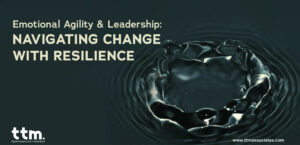
Change is an undeniable part of life, whether it is starting a new job, dealing with personal challenges, or navigating the uncertainties of a changing world. Coping with change can be both challenging and exciting. In these times, emotional agility and resilience are indispensable qualities. Emotional agility means being adaptable and strong when dealing with our feelings in the face of change’s complexities.
Recognizing and understanding why people resist change is closely connected to having first a heightened sense of self-awareness. This self-awareness is equally important for leaders. If you’re a leader encountering resistance from your team because they’re concerned about how the change might affect their abilities, taking proactive steps like creating a tailored learning plan to equip them with the necessary skills and behaviours can be incredibly beneficial.
Similarly, if your team worries that a change might limit their autonomy and engagement, involving them in the decision-making process can be a potent solution to reduce resistance. Even if your team disagrees with the organisation’s chosen direction, your impact through leading by example in the implementation process can help them regain a sense of control, ultimately leading to more resilience.
Rather than viewing resilience as an inherent trait, think of it as a state that any employee can achieve. Creating environments that actively encourage and support resilience is crucial. Does your organisation foster a culture where employees feel comfortable expressing their concerns, seeking resources, and sharing their ideas?
Fostering a positive and emotionally agile culture starts with leaders’ self-regulation and recognizing the impact of their actions. By modelling emotional flexibility and resilience, leaders set a positive example for their teams. This lays the foundation for an open, respectful, and emotionally resilient workplace culture where employees can freely express themselves and adapt effectively to change and challenges by understanding different techniques to manage change. Thus, cultivating emotional agility among leaders is pivotal in promoting emotional well-being and overall organisational success.
For leaders, nurturing emotional agility means recognizing and validating diverse emotions as valid responses to the situation. This validation creates an environment where individuals feel heard and understood, especially during times of change. When leaders validate various emotions within their team, it fosters a culture of empathy and resilience. Team members learn that it is acceptable to express their feelings, whether they’re anxious about the unknown or grieving past circumstances. This collective acceptance of understanding others’ emotions contributes to the development of a resilient workplace culture, where open communication and mutual support thrive, ultimately strengthening the organisation, as a whole.
While accepting negative emotions is important, leaders should differentiate between acceptance and action. Leaders are encouraged to pause and consider whether their emotional reactions align with their values and contribute to the company’s vision. Prioritizing values-based decisions over emotion-based ones enables leaders to shape a workplace culture rooted in the organisation’s core values, rather than solely relying on emotional responses.
As leaders, embracing growth and learning is essential. Change provides an opportunity for personal growth and acquiring new skills. By fostering emotional agility, not only leaders will have the drive to achieve personal and organisational goals, but this also enables teams to view challenges as opportunities for developing resilience and enhancing skills. This perspective shift motivates the team and encourages it to see change as a stimulator for self-improvement rather than an invincible obstacle.
Shifting leadership mindsets and behaviours in an atmosphere of change can be challenging for leaders. Traditional hierarchies often prioritize safety over innovation, with leaders at the top accustomed to making decisions that flow down the pyramid. Embracing an emotionally agile leadership style requires a well-structured program that raises awareness among leaders and teams about the evolving organisational culture. Achieving buy-in from both leaders and teams is essential to guide this transition and offer an external perspective to leaders.
Transitioning to an emotionally agile culture is a time-intensive process that affects all aspects of the organisation. At the same time, leaders must understand emotionally agile methodologies and understand their role in supporting their teams. These shifts require strong executive sponsorship, enabling the recruitment of talent from across the organisation and ensuring they have the necessary tools and an enabling work environment to meet the organization’s needs.
Discover more about Emotional Agility and other solutions provided by TTM Associates at your Behavioural Leadership approach: Skills to Behaviours!














